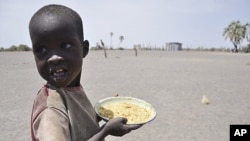Experts are wrapping up meetings in Nairobi this week to look at options for mitigating drought-induced food shortages. They say pastoralism is the best land-use practice in the region's drylands and are looking at ways to help herders maintain their lifestyle.
Herders have been getting a bad environmental rap. The common thinking is that large groups of animals wandering around a parched, drought-stricken territory further degrade the land and water supplies.
The best strategy, popular opinion suggests, is to settle herders onto farms to grow their own food, especially in times of severe food insecurity.
Bad idea, says David Mwangi, researcher with the Kenya Agricultural Research Institute.
“Pastoralists would move in search for pasture, and also water, because what then would happen, if you are in a small area, the moment the water is exhausted, you’d have to move to the next area where there is water. It gives the area you have left time to re-generate and by the time you come back through the loop, this area now has pasture to graze,” Mwangi said.
But, says Mwangi, farming in arid and semi-arid areas - especially during a drought - is not sustainable or even realistic, given the absence of water, poor soil quality, and the difficulties of implementing irrigation.
Mwangi and other experts say that pastoralism is the most efficient use of arid and semi-arid lands, both environmentally and economically.
Jeff Hill, director of policy for the Bureau of Food Aid at USAID, describes the value of arid and semi-arid lands to the region’s economies. Arid and semi-arid lands comprise some 80 percent of the Horn of Africa. “Their livestock-based economies drive a value chain which constitutes 35 to 40 percent of agricultural GDP (gross domestic product) in Ethiopia and 45 to 50 percent of the agricultural GDP in Kenya. In Somalia, livestock systems fuel the economy,” Hill said.
Livestock is sold for cash, as well as providing meat, milk and other by-products to families. The Intergovernmental Authority on Development estimates that over 90 percent of meat consumed in East Africa comes from pastoralist herds. Kenya’s pastoral livestock sector is estimated to be worth some $800 million.
But herders and their lifestyles have long been looked down upon, viewed as being “backwards.” Arid and semi-arid lands have often been excluded in government planning, with very few roads and other infrastructure being built.
Hill says it is only recently that the Kenyan and other governments have recognized the value of arid and semi-arid lands and have put the development of these areas into national plans such as Kenya’s Vision 2030.
Experts say ensuring that herders and their livestock have access to grazing and watering areas - especially during the dry season - is critical to preventing famine in arid and semi-arid lands. But conflict over these resources and poor roads and other infrastructure are some of the factors that restrict herders’ access.
During their meeting this week, scientists and other experts discussed concrete ways to support herders and their lifestyle.
Kenya Agriculture Research Institute’s Mwangi describes a project in Kenya’s Chalbi Desert in which grass is grown to feed livestock. He says communities need to be creative with the resources they have, giving the example of rangeland near the Tana River in Eastern Kenya.
“What would happen if we developed a system where we grow fodder and pasture along the river, and the animals are taken off from the range and finished nearer to the market? What we really need is a system, and that is what has been really lacking,” Mwangi said.
He says more efforts also need to be put into camel rearing, as camels tend to be the only livestock that lactate during a drought.
Herder Nixon ole Parmisa describes for VOA more support strategies. “If there is a drought, we need to have some drought mitigation measures. Now you warn the community (that) the drought is coming, so what do you do? Sell your livestock. Maybe the government will buy - the Kenya Meat Commission - at a good price, so sell. And the community will be very much willing to sell,” Parmisa said.
A recent report by the International Livestock Research Institute lists additional pastoral-support strategies, including the construction of roads, access to market information, and schemes that pay herders for wildlife conservation and other ecological services.
Experts Debate How East Africa Livestock Herders Should Handle Drought









